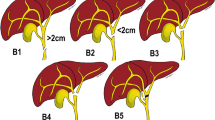Abstract
Injury to the extrahepatic biliary tract occurs frequently due to damage inflicted during upper abdominal operations, cholecystectomy being the commonest situation followed by other upper abdominal surgeries, and less often due to blunt or penetrating abdominal injury. Most traumatic extrahepatic biliary tract injuries are caused by penetrating trauma and are usually discovered during laparotomy. Diagnosis is made by noting the accumulation of bile in the upper quadrant. The gallbladder is the most commonly injured structure. Regardless of the type of biliary injury and/or management, wide and adequate drainage is essential. Any upper abdominal operation can result in biliary tract injuries. Cholecystectomy is the procedure most implicated in biliary tract injuries because it is one of the most common elective surgeries performed worldwide. If not managed properly, bile duct injuries can lead to life-threatening complications. Identification and management of biliary tract injuries demand precise judgement, expertise, timely and appropriate intervention and prevention of complications. This study aims to present detailed information and an update on biliary tract injuries.
Similar content being viewed by others
References
Posner MC, Moore EE. Extrahepatic biliary tract injury: operative management plan. J Trauma 1985;25:833–7.
Zago TM, Pereira BMT, Calderan TRA, et al. Extrahepatic duct injury in blunt trauma: Two case reports and a literature review. Ind J Surg 2014;76:302–7.
Zellweger R, Navsaria PH, Hess F, et al. Gall bladder injuries as part of the spectrum of civilian abdominal trauma in South Africa. ANZ J Surg 2005;75:559–61.
Bade PG, Thomson SR, Hirshberg A, et al. Surgical options in traumatic injury to the extrahepatic biliary tract. Br J Surg 1989;76:256–8.
Feliciano DV, Bitondo CG, Burch JM, et al. Management of traumatic injuries to the extrahepatic biliary ducts. Am J Surg 1985;150:705–9.
Degiannis E, Khelif K, Leandros E, et al. Gunshot injuries of the extrahepatic biliary duct. Eur J Surg 2001;167:618–21.
Leppaniemi AK, Jokelainen OS, Haapiainen RK. Accidental injuries of the hepatoduodenal ligament. Eur J Surg 1993;159:351–3.
Roslyn JJ, Binns GS, Hughes EF, et al. Open cholecystectomy: A contemporary analysis of 42,474 patients. Ann Surg 1993;218:129–37.
Strasberg SM, Hertl M, Soper NJ. An analysis of the problem of biliary injury during laparoscopic cholecystectomy. J Am Coll Surg 1995;180:101–25.
Deziel DJ, Millikan KW, Economou SG, et al. Complications of laparoscopic cholecystectomy: a national survey of 4,292 hospitals and an analysis of 77,604 cases. Am J Surg 1993;165:9–14.
Nuzzo G, Giuliante F, Giovannini I, et al. Bile duct injury during laparoscopic cholecystectomy: results of an Italian national survey on 56,591 cholecystectomies. Arch Surg 2005;140:986–92.
Waage A, Nilsson M. Iatrogenic bile duct injury: a populationbased study of 152,776 cholecystectomies in the Swedish Inpatient registry. Arch Surg 2006;141:1207–13.
Tantia O, Jain M, Khanna S, et al. Iatrogenic biliary injury: 13,305 cholecystectomies experienced by a single surgical team over more than 13 years. Surg Endosc 2008;22:1077–86.
Pekolj J, Alvarez FA, Palavecino M, et al. Intraopertaive management and repair of bile duct injuries sustained during 10,123 laparoscopic cholecystectomies in a high volume referral centre. J Am Coll Surg 2013;216:894–901.
Ahmad J, McElvanna K, McKie L, et al. Biliary complications during a decade of increased cholecystectomy rate. Ulster Med J 2012;81:79–82.
Joseph M, Phillips MR, Farrell TM, et al. Single incision laparoscopic cholecystectomy is associated with a higher bile duct injury rate: a review and a word of caution. Ann Surg 2012;256:1–6.
*Corvera UC, Alemi F, Jarnagin WR. Benign Biliary Strictures. In: Jarnagin WR, Belghiti J, Buchler MW, Chapman WC, D’Angelica MI (eds) Blumgart’s Surgery of the Liver, Biliary Tract and Pancreas, 5th ed, Elsevier, Philadelphia, pp. 615–22.
*Matthews JB, Blumgart LH. Benign Biliary Strictures. In: Zinner MJ, Schwartz SI, Ellis H (eds) Maingot’s Abdominal Operations, 10th ed, Appleton and Lange, Stamford, pp. 1803-24.
Lee CM, Stewart L, Way LW. Postcholeystectomy abdominal bile collections. Arch Surg 2000;135:538–44.
*Bismuth H. Postoperative strictures of the bile ducts. In: Blumgart LH, (ed). The Biliary Tract, 5th ed, Edinburgh, Churchill-Livingstone, 1982, pp. 209–18.
Bismuth H, Majno PE. Biliary strictures: classification based on the principles of surgical treatment. World J surg 2001;25:1241–4.
Stewart L, Robinson TN, Lee CM, et al. Right hepatic artery injury associated with laparoscopic bile duct injury: incidence, mechanism and consequences. J Gastrointest Surg 2004;8:523–30.
Stewart L, Dominguez CO, Way LW. A data/frame sense making analysis of operative reports. In: Mosier K, Fischer U (eds). Informed by knowledge: expert performance in complex situations. New York, Taylor & Francis, 2011; pp. 329–38.
Rosenthal RJ, Steigerwald SD, Imig R, et al. Role of intraoperative cholangiography during endoscopic cholecystectomy. Surg Laparosc Endosc 1994;4:171–4.
Voyles CR, Sanders DL, Hogan R. Common bile duct evaluation in the era of laparoscopic cholecystectomy. 1050 cases. Ann Surg 1994;21:744–50.
Frilling A, Li J, Weber F, et al. Major bile duct injuries after laparoscopic cholecystectomy: a tertiary centre experience. J Gastrointest Surg 2004;8:679–85.
Nordin A, Halme L, Makisalo H, et al. Management and outcome of major bile duct injuries after laparoscopic cholecystectomy: from therapeutic endoscopy to liver transplantation. Liver Transpl 2002;8:1036–43.
Stewart L, Way LW. Repair of laparoscopic bile duct injuries: timing of surgical repair does not influence surgical rate. HPB 2009;11:516–22.
De Reuver PR, Grossmann I, Busch OR, et al. Referral pattern and timing of repair are risk factors for complications after reconstructive surgery for bile duct injury. Ann Surg 2007;245:763–70.
Author information
Authors and Affiliations
Corresponding author
Rights and permissions
About this article
Cite this article
Chaudhary, P., Kumar, R. & Arora, M.P. Biliary tract injuries. Hellenic J Surg 87, 149–155 (2015). https://doi.org/10.1007/s13126-015-0200-y
Received:
Accepted:
Published:
Issue Date:
DOI: https://doi.org/10.1007/s13126-015-0200-y




